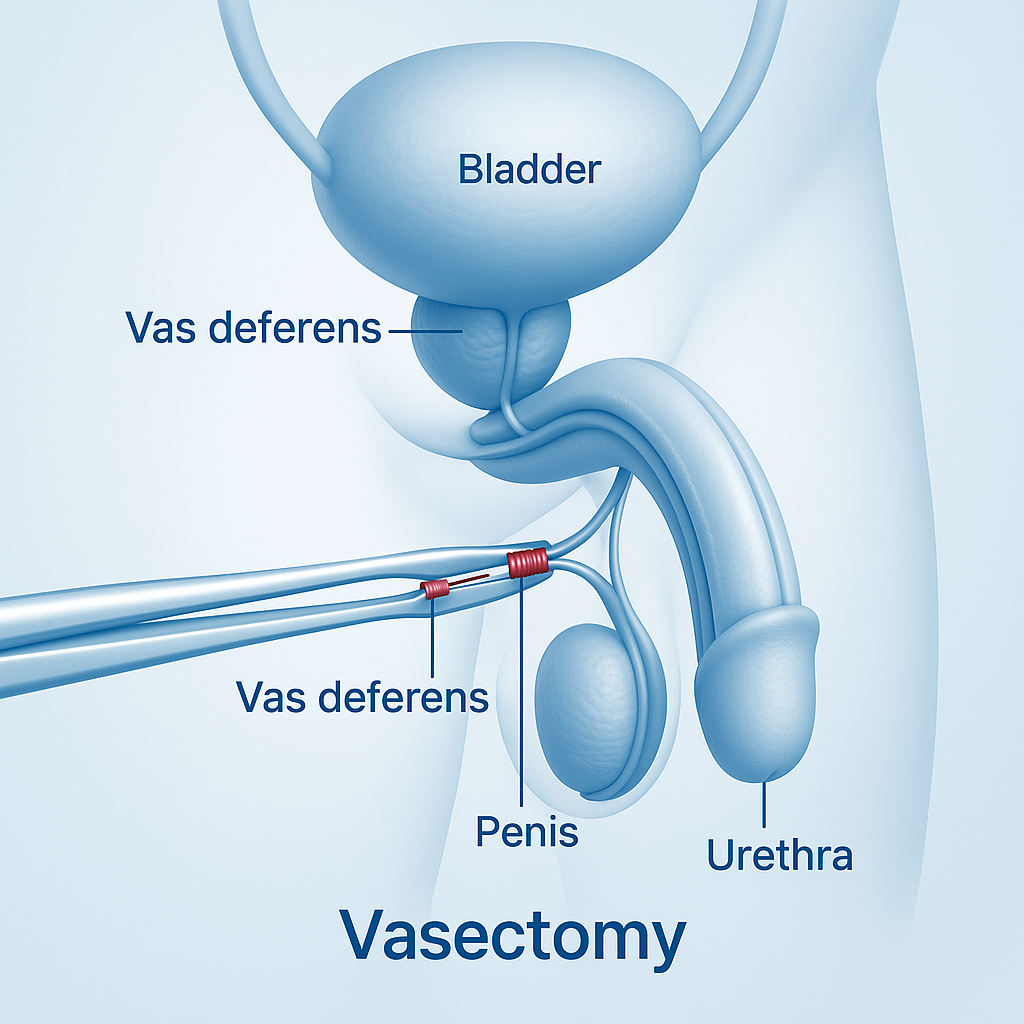Urology Surgical Procedures
Urology Surgical Procedures
Welcome to our Urology Surgical Procedures section.
Our department provides advanced surgical care for urinary and male reproductive system conditions.
We perform both traditional and minimally invasive surgeries to ensure effective treatment, minimal pain, and quick recovery.
 Vasectomy – Permanent Male Contraception
Vasectomy – Permanent Male Contraception
Overview:
Vasectomy is a safe and permanent form of birth control for men. It prevents sperm from mixing with semen during ejaculation.
Why It’s Done:
Long-term family planning
Permanent contraception
Simple outpatient procedure
How It’s Performed:
Under local anesthesia, a small incision or puncture is made in the scrotum. The vas deferens (sperm tubes) are cut and sealed using clips or cauterization. The procedure takes around 20–30 minutes.
Recovery & Aftercare:
Mild swelling or discomfort may last a few days. Rest, ice packs, and supportive underwear help healing.
Sexual activity can resume after about one week.
Risks:
Temporary soreness or bruising
Minor infection (rare)
Benefits:
99% effective
No effect on sexual function or hormones

 Vasectomy Reversal – Restoring Fertility
Vasectomy Reversal – Restoring Fertility
Overview:
Vasectomy reversal reconnects the vas deferens to restore the natural flow of sperm and fertility.
Why It’s Done:
Desire to conceive again
Change in family plans
How It’s Performed:
Performed under anesthesia using microsurgical techniques. The surgeon carefully rejoins the vas deferens with fine sutures under magnification. Duration: 2–4 hours.
Recovery & Aftercare:
Most patients recover within a week. Semen analysis is done after 2–3 months to assess sperm return.
Risks:
Infection
Recurrence of blockage
Benefits:
Restores natural conception potential

 Circumcision – Foreskin Removal Procedure
Circumcision – Foreskin Removal Procedure
Overview:
Circumcision is the surgical removal of the foreskin covering the head of the penis. It can be done for medical, hygiene, or cultural reasons.
Why It’s Done:
Tight or infected foreskin (phimosis)
Recurrent inflammation
Personal, religious, or hygiene purposes
How It’s Performed:
Performed under local or general anesthesia. The foreskin is surgically removed and the wound is closed with dissolvable stitches.
Recovery & Aftercare:
Healing time is about 7–10 days. Keep the area clean and dry. Avoid sexual activity until fully healed.
Risks:
Mild bleeding or infection
Swelling or tenderness
Benefits:
Improved hygiene
Reduced risk of infections and inflammation

 Prostate Procedures (TURP & Prostatectomy)
Prostate Procedures (TURP & Prostatectomy)
TURP – Transurethral Resection of the Prostate
Overview:
TURP removes part of an enlarged prostate that obstructs urine flow (Benign Prostatic Hyperplasia – BPH).
Procedure:
A resectoscope is inserted through the urethra. Excess prostate tissue is trimmed away without external incisions.
Recovery:
Short hospital stay (1–2 days). Temporary catheter placement. Full recovery in 2–4 weeks.
Prostatectomy – Prostate Removal Surgery
Overview:
Prostatectomy removes part or all of the prostate gland, typically for prostate cancer treatment.
Procedure:
Performed under general anesthesia via open, laparoscopic, or robotic surgery.
Recovery:
Hospital stay 2–4 days. Gradual improvement over several weeks.
Risks:
Bleeding or infection
Temporary incontinence
Sexual side effects (rare)
Benefits:
Relieves urinary obstruction
Treats or removes prostate cancer

 Nephrectomy – Kidney Removal Surgery
Nephrectomy – Kidney Removal Surgery
Overview:
Nephrectomy involves removing all or part of a kidney due to cancer, trauma, or severe infection.
Why It’s Done:
Kidney cancer
Severe damage or non-functioning kidney
Organ donation
How It’s Performed:
Under general anesthesia, the kidney is removed through open or laparoscopic surgery.
Recovery & Aftercare:
Hospital stay: 2–5 days. Avoid lifting heavy objects for 4–6 weeks. Most people live normally with one healthy kidney.
Risks:
Infection
Bleeding
Injury to nearby organs (rare)
Benefits:
Removes diseased tissue
Can save or extend life

 Cystectomy – Bladder Removal Surgery
Cystectomy – Bladder Removal Surgery
Overview:
Cystectomy removes part or all of the bladder, commonly to treat bladder cancer or severe bladder dysfunction.
How It’s Performed:
Under general anesthesia, the bladder is removed, and a new urinary passage (neobladder or stoma) is created.
Recovery & Aftercare:
Requires a hospital stay and post-surgery catheter care. Full recovery may take several weeks.
Risks:
Infection
Bleeding
Digestive or urinary changes
Benefits:
Effective cancer treatment
Improves quality of life in severe cases

 Kidney Stone Treatments – SWL & PCNL
Kidney Stone Treatments – SWL & PCNL
Shockwave Lithotripsy (SWL)
Overview:
SWL uses focused sound waves to break kidney stones into tiny fragments that pass naturally in urine.
Advantages:
Non-invasive
Outpatient procedure
Quick recovery
Recovery:
Mild soreness or blood in urine for 1–2 days. Return to normal activities quickly.
Percutaneous Nephrolithotomy (PCNL)
Overview:
PCNL removes large or complex stones through a small incision in the back.
Procedure:
Under anesthesia, a small channel is created to access and extract stones directly from the kidney.
Recovery:
Hospital stay: 1–2 days. Full recovery within 1–2 weeks.
Benefits of Both Treatments:
High success rate
Minimal pain and scarring
Faster healing than open surgery

 Book Your Urology Surgery Appointment Today
Book Your Urology Surgery Appointment Today
Our experienced urology team provides safe, effective, and minimally invasive surgical treatments tailored to each patient’s needs.
Contact us today to schedule your consultation.


 Vasectomy – Permanent Male Contraception
Vasectomy – Permanent Male Contraception Vasectomy Reversal – Restoring Fertility
Vasectomy Reversal – Restoring Fertility Circumcision – Foreskin Removal Procedure
Circumcision – Foreskin Removal Procedure Prostate Procedures (TURP & Prostatectomy)
Prostate Procedures (TURP & Prostatectomy) Nephrectomy – Kidney Removal Surgery
Nephrectomy – Kidney Removal Surgery Cystectomy – Bladder Removal Surgery
Cystectomy – Bladder Removal Surgery Kidney Stone Treatments – SWL & PCNL
Kidney Stone Treatments – SWL & PCNL Book Your Urology Surgery Appointment Today
Book Your Urology Surgery Appointment Today